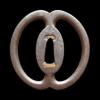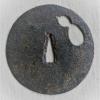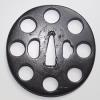-
Posts
95 -
Joined
-
Last visited
-
Days Won
1
Emil last won the day on September 16 2024
Emil had the most liked content!
Profile Information
-
Gender
Male
-
Location:
Nordic
Profile Fields
-
Name
Emil
Recent Profile Visitors
3,093 profile views
Emil's Achievements
-
Perfect, thanks! @ROKUJURO
-
Yes, it's only the Koshirae tsuka, the saya fits well Thank you! This is really valuable advice @Brian @Robert S
-
I was thinking along the lines of using a small file and adjusting it without disassembling it. It turns into a international project if I need to have the handle rewrapped.
-
Emil started following Giving a nihonto some use ? , Overly tight tsuka and New sword law in Japan?
-
Since purchasing this katana in Tokyo, it has now experienced all four seasons here in Scandinavia. Even from the start, the tsuka has always been overly tight. While it's slightly more manageable in the dry winter months, the fit is still too tight year-round, and it worsens noticeably in the humid summer. The mekugi it came with is aggressively tapered, which hints that it was a long time ago the mekugi ana aligned well. The shirasaya tsuka surprisingly fits perfectly all year round. The blade is a Showa-era military piece that was used for tameshigiri in Japan, which is why it’s mounted in uchigatana-style koshirae. Unfortunately, sending it back to Japan for professional adjustment isn’t an option. Would it be too risky to attempt a careful adjustment myself? At this point the tsuka risks getting damaged from just mounting it in Koshirae, potentially worsening the cracks in the tsuka.
-
There's a dojo in Japan that I've visited in the past to experience some Iaido and tameshigiri. I'm going back there next week. I was informed by the staff that we can't do tameshigiri unless I use my own sword this time. They told me that it's a new sword law that prevents them from renting out swords. So no more tameshigiri for tourists I take it? I tried to find more info about this on google but I couldn't find anything. Anyone here with more insights on the topic?
-
This is the same explanation as I got to why kiri bako are used to store swords. When the air is dry, the wood release its moisture and when the air is humid, it absorbs moisture. This way, it's creating a more stable climate for the blade and Koshirae stored inside the box. On top of that, paulownia wood used for kiri bako have the additional benefit of natural pest reppellants and having one of the most thermally insulating properties of all woods. These additional benefits are not necessarily same for shirasaya, as it is made of Japanese magnolia.
-
Sword polishing comes in different levels based on purpose and budget. A basic "tameshigiri polish," focused solely on sharpness, costs around $600-$1,000 USD, while a high-grade "art polish," aimed at enhancing the blade’s beauty, can exceed $2,500 USD. If you plan to cut with your sword, expect scratches and minor bends, these are unavoidable and should be handled by a professional polisher. For practitioners outside Japan, use a chinese made reproduction sword for cutting. .
-

Giving a nihonto some use ?
Emil replied to Nicolas Maestre's topic in General Nihonto Related Discussion
Unless you're living in Japan you shouldn't follow the Japanese example. It's totally different circumstances due to their laws. If you want to cut tatami or practice Iai with a Shinken inside Japan, you're bound to use Nihonto. For many, an old sword will be more affordable than a newly made sword. I've personally talked to Japanese Togishi who were totally unaware that we can buy shinken from China for as low as 100-200 USD. Whenever you read anything from the Japanese you have to keep in mind that it's likely said from the viewpoint of having little to no alternative, and most of them are unaware that we have better alternatives. If they had a choice they would likely do things differently. -

Giving a nihonto some use ?
Emil replied to Nicolas Maestre's topic in General Nihonto Related Discussion
Beheadings, on the other hand, I fully support. It will only increase the value of the sword 😂 -

Giving a nihonto some use ?
Emil replied to Nicolas Maestre's topic in General Nihonto Related Discussion
I actually agree with this, to a point. If anyone were qualified to use a Nihonto, it would be someone with over 10 years of iai experience, skilled enough to draw smoothly, and avoid damaging the blade. That said, I still think using a nihonto as a regular training tool would be risky, occasional use for a significant demonstration might seem more acceptable, but there are two major drawbacks: 1. As an experienced iaidoka, you’re setting a standard for less experienced practitioners. Using a nihonto could inspire others to follow your example. 2. The sword you train with should be the one you know best. Only using it on rare occasions goes against that, adjusting to its unique shape would probably lead to unnecessary wear. In my opinion, the best approach would be to have a custom shinsakuto made for you. And as a bonus, when your custom Nihonto is passed down generations, your contribution to keeping the art of nihonto craftsmanship alive would live on with the history of the sword. That is something to be truly proud of. -

Giving a nihonto some use ?
Emil replied to Nicolas Maestre's topic in General Nihonto Related Discussion
If this is a repetitive question here I understand there might be some built up frustration coming out here. Otherwise I think the question was asked in a good manner. And from someone who has spent a considerable amount of his life developing his sword skills. There are a lot of people out there who will ask nobody before they use Nihonto for backyard cutting until the sword looks like an old rusty saw. I myself have cut tatami with a koto blade, but that was in Japan and not on my own initiative. I wouldn't dream of doing it outside of Japan. My position is that we have to keep in mind that we are only the caretakers of these historic swords for a while before they continue down the history. Our lives are just a blip in the history of the sword, and if every blip wants a piece of the sword, it won't last very long. For each generation of users, the finite pool of antique katans gets even smaller. In the future, prestine katanas will be very rare. By using this katana, you are not doing your best to preserve it for future generations. Previous owners throughout history did not take this well care of their swords and pass it on until it reached us, so we can start putting miles on them. There is something beutifully humble about viewing yourself as the caretaker and not the end user of a sword. I'd still say that after 15 years of Iai you probably have the skills to not do much damage, but I'd rather not anyway. For the Japanese the blades serve ritualistic and even religious purposes. They are believed to expel evil and protect the house from bad spirits. Maybe adopting a similar mindset and start viewing it as your lucky charm will make it feel more like it has a purpose? -
What kind of sword do you use what steel is it? I've seen people reference to iai and samurai for this in the past as well. They claim if you use your sword often enough and just wipe it every time after use, it will be fine. Which technically must come down to airing the saya and wiping of any built up moisture from the blade once a week?
-
I agree with you, it's probably a better idea to display an iaito. Just out of curiosity, some Japanese sword shops that I've been to, display their blades in open air all day long, every day. This one for example displays probably a hundred blades outside of both koshirae and shirasya, some of them with a pricetag up to 2.3M JPY. They have a rack of 10-20 Shinsakuto sold only in Koshirae, you don't even get a Shirasaya. And they are also displayed in open air. I was curious to how they manage to maintain all those swords while customers are free to walk around and breathe on them.
-
I recently gifted my father a Showato in traditional Shirasaya and Koshirae that I bought from Aoi Art along with a kiri bako for ideal storage. He wants to enjoy this sword by storing it in Koshirae on a wall hanger at up to a week at a time. As I've mentioned in another post it already has some tiny rust spots along the blade and I don't want to make it worse, but I do understand his desire to showcase it for a few days occasionally. Any advice on storing a katana sitting in its Koshirae on a wall openly? Should I tell him it's better to just display the Koshirae with the tsunagi? Or is one week at a time in Koshirae fine? I already told him not to put the wall hanger close to the fireplace or windows to save the lacquer from rapid changes in temperature and direct sunlight. Any advice would be highly appreciated
-
Hi Paul! Yes that's the book I was looking for, and any references to Swedish steel in it. I believe Bruce got me everything in there already. Thank you!




















